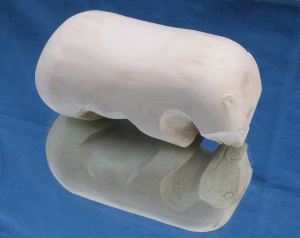Anyone working in wood will be able to tell you about this…
I mentioned a while back that I had carved a couple of little animals for Ella and Toby, children who live next door. Toby’s little brother has asked me to carve him a bear – a bear on its hind-legs, roaring, to be precise. To be honest, I’ve been putting this off. Partly, it’s because I have a couple of jobs to complete for colleagues in the Education and Events Teams at English Heritage. Partly (mostly, let’s be honest), it’s because a bear is really hard. Really hard for me, given that my woodworking is mostly limited to spoons, bowls and other hollow forms, and spindle turning on the pole lathe.
Nevertheless, I thought it was about time I got on with the bear.
My original thought was to base the piece on heraldic bears. A simplified version of the Warwick bear and ragged staff perhaps, and I did some sketches. But my carving’s not up to that, so I turned to the bears that I saw at the British Museum’s Ice Age Art exhibition. The bear is a common motif in both Palaeolithic portable and mural art. There is an almost complete bear in the ceramic assemblage at Dolni Vestonice, for example, as well as another 20-odd incomplete figures; bear heads from Kostienki 1; and two fabulous bears painted onto the cave wall at Ekain. I love these two bears for their simplicity – the artist has perfectly captured the form with a few well-drawn lines.

Bear rough-out in apple
I cut myself a piece of apple roundwood. The branch had come from a friend earlier this year, shortly after it had been cut from the tree, and had been standing upright in my store for a few months. I had started to rough-out the shape of an ambling bear, head down, snuffling at the ground.
The weather has been jolly hot and dry. The piece of unseasoned apple, freed from its parent branch and divested of its bark, started to dry out very quickly (and unevenly). The more wood I cut away, the greater the surface area (in relation to volume of wood) became; and the faster it dried. The inevitable has happened.

Bear rough-out in apple
A number of radial cracks have developed in the piece. It took no more than a day for one of these to run the whole length of the bear. The greatest shrinkage in roundwood like this will always be in its tangential plane, and most quickly from its outside surfaces. It’s no surprise that this piece has pulled itself apart in this way. Time to start again…
Bahn, P.G. and Vertut, J. (1988) Images of the Ice Age Leicester: Winward PressCook, Cook, J. (2013) Ice Age Art London: The British Museum Press



